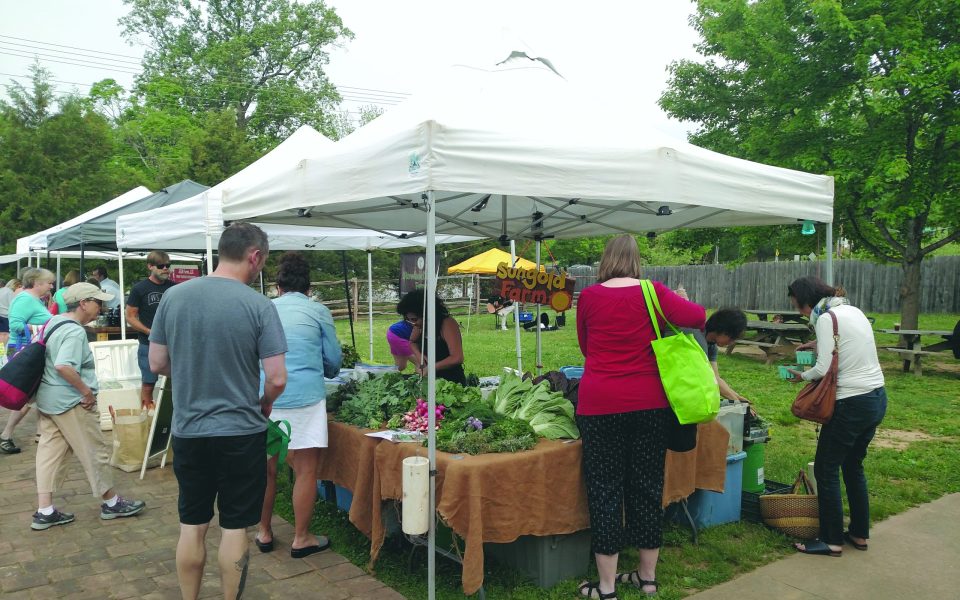They come in caravans like a carnival along the old brick and cobblestoned roads in the cool mist of a May morning. Bearing their best variety of vegetables plucked from the earth and cuts of poultry, beef and pork who shared the same earth. Tents pop into shape and signs swing in the breeze.
The crowds come early, walking among the vendors’ tables, getting a first look at what the spring brought forth. Lines form in front of tables colored in leafy greens, wild mushrooms and fresh flowers. Across the rows of tents, applause and cheering breaks as the clock bell tolls 9 a.m. and the market begins.
From the first breath of April to the end of November, the gardens at the corner of West and Salt streets at historic Old Salem fill with customers from across the Triad. And although dozens of supermarkets are scattered across the city, it is clear that the Cobblestone Market offers something of greater value. As shoppers taste, smell and select the items that catch their eye, farmers stand across the tables, closing the gap between buyer and grower. Any and all questions of where fruits and vegetables and meats came from, how they were grown and even the farmers’ techniques for cooking and growing, can be answered on the spot.
Since launching in 2011, the Cobblestone Market has expanded its access beyond the task of bringing the freshest organic and responsibly grown produce and meats to the public. Cobblestone sustains an ever-increasing ease for customers, accepting payment through government assistance programs like SNAP in order to help improve food access across the community. They offer recipes and weekly menus for customers, informing them how to cook with the seasons in order to make use of what is currently growing. Over 50 vendors and farms, from the heart of the Triad to southern Virginia, now participate in the market each weekend.
Beyond the food, there is a certain communal consciousness and camaraderie. Customers and vendors alike take part in true stewardship of the land, dedicated to creating clean, responsible practices in the growing process, as well as ensuring humane care and raising of animals.
Cobblestone brings access to producers who grow and sell items that can rarely be found in supermarkets. Among these producers are Borrowed Land Farms and Fungus Lab, a family-operated mushroom farm located on the foothills of Pilot Mountain. From oyster, lion’s mane, pioppino and chestnut mushrooms to wild grown shiitake, hen of the woods and chicken of the woods, the mushrooms are foraged and brought immediately to market.
On the carnivorous side, Meadows Family Farm — located on a self-sustaining farm that stretches between Guilford and Moore counties — offers free-range, grass-fed beef and cage-free pork and chicken.[pullquote]Visit cobblestonefarmersmarket.com to find more information on producers and upcoming dates.[/pullquote]
Before even an hour into the market, hundreds of shoppers roam from tent to tent, and lines formed 10, 20 people deep to purchase limited quantities of produce or meats before they’re gone.
Cobblestone Market sits in the same location as the gardens Moravians planted more than 250 years ago. It is the same fertile ground that fed generations of families, ground where a community continues to find sustenance.
In less than three hours, the length the market runs on Saturdays, dozens of growers are sold out of their produce. Shoppers walked back to their cars with arms loaded down with bags of vegetables. And as the last items were sold, tents were broken down and folded up as growers loaded up what might be left over, and returned back to their farms and greenhouses to continue their sowing.
Join the First Amendment Society, a membership that goes directly to funding TCB‘s newsroom.
We believe that reporting can save the world.
The TCB First Amendment Society recognizes the vital role of a free, unfettered press with a bundling of local experiences designed to build community, and unique engagements with our newsroom that will help you understand, and shape, local journalism’s critical role in uplifting the people in our cities.
All revenue goes directly into the newsroom as reporters’ salaries and freelance commissions.


Leave a Reply